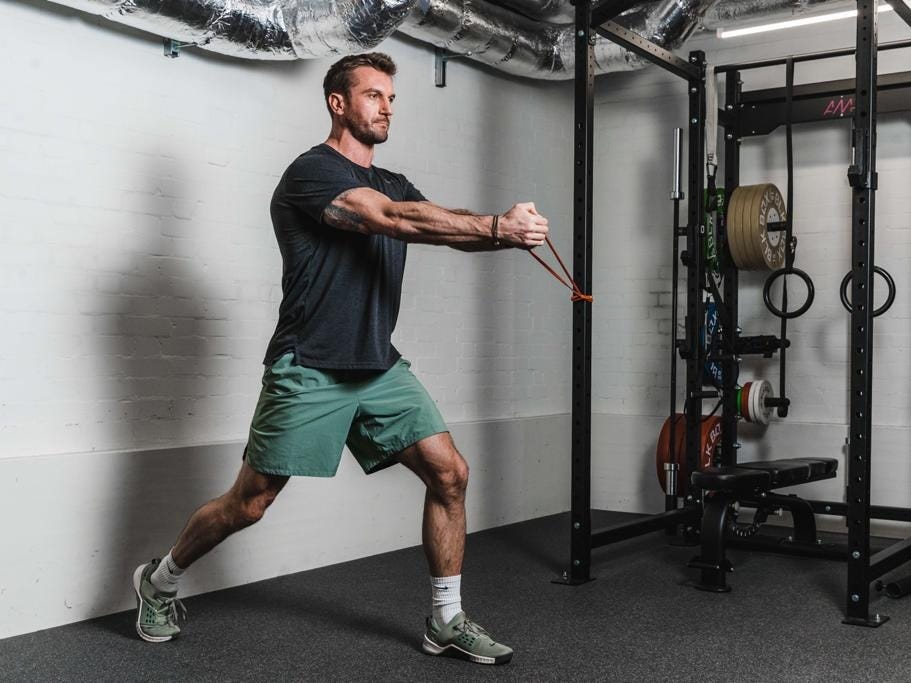
Getty/Mireya Acierto
- Traditional gym lore says that rep range determines if you'll build strength, muscle, or endurance.
- However, load, speed, and "time under tension" are actually more important than the number of reps.
- Equally, your body reacts best to what's new, so it's worth employing various training styles.
- Visit Insider's homepage for more stories.
Lifting weights is, as endless research shows, an incredible way to get stronger, build muscle, burn fat, increase endurance, relieve stress, and improve a variety of health markers.
But the term "lifting weights" covers all manner of sins – there are many ways to do it.
Traditional fitness lore dictates that the rep range you choose will determine the outcome for your body. Long established gym-bro wisdom says that working in sets of around 3-7 reps is how to build strength, 8-12 is the ballpark for hypertrophy (muscle growth), and 12+ is endurance training or "toning."
Of course, the rep range you choose requires scaling your weights accordingly: You can lift heavier weights if you're doing fewer reps.
Rep ranges aren't as clear cut as many people think
According to UK strongest man Adam Bishop, the rep range rule "is just not true."
"If you're training with intensity, it doesn't matter," he told Insider. "You're going to be getting some kind of hypertrophic effects, whether it's training high reps or low reps."

Adam Bishop
In terms of volume, performing three sets of five squats with 80 pounds weight is the same as three sets of 10 squats with 40 pounds weight.
But do both have the same effect on the body?
Some people argue that it doesn't matter which training style you choose as long as you're training to near failure to induce muscle adaptation.
"Whilst rep ranges are a useful guide - we have to keep in mind that training our bodies is a physiological process that relies on adapting to a specific stress," personal trainer and human movement specialist Luke Worthington told Insider. "It is the quantity and quality of that stressor, and subsequent recovery, that determines progress, rather than a specific number of repetitions."
Rep range isn't as important as people think
Load (the weight you're lifting), speed, and "time under tension" are more important than the number of reps, Worthington said.
For strength-building, the weight you're lifting is most important, and there's some logic to say 3-6 reps is correct, provided the load is adequate.
For muscle-building, it's time under tension that matters most - this means how long you're working for.
"Training for hypertrophy requires causing 'metabolic damage' to muscle cells, and then refueling them with a surplus of amino acids [through protein] and calories to lay down new muscle tissue," Worthington said. "Metabolic damage is more closely correlated with 'time under tension' than number of repetitions."
Ideally, you should be working for 60-90 seconds per set, and the number of reps you perform in that time depends on your tempo. As a blanket rule, Worthington recommends 12-15 reps to hit that time under tension mark.

Luke Worthington
Lifting heavier weights for fewer reps doesn't provide as much time under tension so is less ideal for muscle growth.
It's often said that 12-15 reps is the "toning" range, but "toning" doesn't exist - you cannot "tone" a muscle. In fact, performing 12-15 reps with a moderate weight is likely to provide the sweet spot for hypertrophy, according to Worthington.
As for the "endurance" claim of higher rep training, this is something of a misnomer.
"Endurance for runners or cyclists etc is built by running and cycling," Worthington said. "A runner will take tens of thousands of steps in an event, so a weight training set of 15 reps will be relatively insignificant to them. For building endurance, I would be saying focus on strength to give you the robustness to build your endurance in your actual event."
Your body reacts best to whatever is new
If you're an experienced weight lifter, you may look back longingly at your early days in the gym and dream of having those so-called "newbie gains" again. When you're new to resistance training, your body responds incredibly well and you can make impressive progress in strength and muscle growth quickly.
"You remember when you first went into the gym and you lifted, and then the next session you could lift more? That's a neural adaptation, your body getting used to being able to use those motor units," Bishop said.
While this does sadly slow down, you can mimic the effect to an extent by changing your usual rep range.
If strength is your goal, Bishop recommends training in both the classic strength and hypertrophy rep ranges.
"You definitely should be doing some higher rep training periodically to make sure the muscle actually gets bigger," he said, adding that performing reps focused on stability and form is also important.
"With the low reps, you actually can improve your form a lot more if the load is right. So I advocate a mix of the two. That's the whole point of what we call 'periodization of training,' which is training different things at different times to be able to focus on that end goal. People should be training through a lot of the rep schemes."
